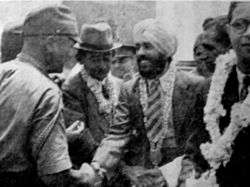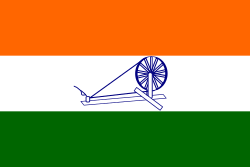F Kikan
Fujiwara kikan (藤原機関, Fujiwara or Efu (F) Kikan) was a military intelligence operation established by the IGHQ in September 1941. The Unit was transferred to Bangkok at the end of that month and headed by Major Fujiwara Iwaichi, chief of intelligence of the 15th army. Its task was to contact the Indian independence movement, the overseas Chinese and the Malayan Sultans with the aim of encouraging friendship and cooperation with Japan.[1] The unit was notable for its success in establishing cooperative ties between the Empire of Japan and the Indian independence movement, overseas Chinese and various Malay sultans.[1]

History and development
Based on experiences in China, the Imperial Japanese Army established a semi-autonomous unit to carry out liaison duties with local independence movements in Southeast Asia and transmit intelligence gathered from these movements back to the army command. Two such units were established before the outbreak of World War II in South-East Asia: the Minami Kikan and the F Kikan.[2]
The F-Kikan was named after its leader, Major Fujiwara Iwaichi, chief of intelligence of the Japanese 15th Army, initially stationed in Bangkok in late 1941. Fujiwara's staff included five commissioned officers and two Hindi-speaking interpreters. Fujiwara's motto was that the intelligence activity for Imperial Japanese Army is "ultimate sincereness".
After the attack on Pearl Harbor, the 15th Army was tasked with the invasion of Malaya, during which time F-Kikan rescued Sultan Abdul Hamid Halim of Kedah and his family. His son (and future Malaysian Prime Minister) Tunku Abdul Rahman made a radio announcement urging the Malay people to cooperate with Japan. F-Kikan also attempted to mobilize the anti-British Kesatuan Melayu Muda, but since most of its leadership had been arrested by the British shortly after the start of the war, its impact was minor.
The F-Kikan was also instrumental in establishing relations with Indonesians resistance movements against Dutch colonial rule, especially in Aceh in northern Sumatra, which formed a backdrop to the Japanese occupation of Indonesia.[3]
However, F-Kikan's greatest success was in its contacts with Indian independence leader Giani Pritam Singh Dhillon and Captain Mohan Singh, and recruitment of some 40,000 Indian prisoners of war into what eventually became the Indian National Army.[4] This development was a tremendous coup for the Japanese government, and was a direct threat to the British position in India.
After the British surrender of Singapore in 1942, F-Kikan was dissolved, and replaced by a new liaison agency, the Iwakuro Kikan, or "I-Kikan", to coordinate activities between the Indian National Army and the Japanese army.
See also
Notes
- Lebra 1977, p. 23
- Newell 1981, pp. Allen L, in Newell 1981, 83
- Indonesian Volunteers in the Japanese Army.
- Lebra 1977, p. 24
References
- Lebra, Joyce C. (1971), Japanese trained Armies in South-East Asia, New York,Columbia University Press, ISBN 0-231-03995-6.
- Fay, Peter W. (1993), The Forgotten Army: India's Armed Struggle for Independence, 1942-1945., Ann Arbor, University of Michigan Press., ISBN 0-472-08342-2.
- Newell, W.H. (1981), Japan in Asia, 1942-1945, National University of Singapore Press, ISBN 9971-69-014-4.
- Fujiwara, Iwaichi (1983). F. Kikan: Japanese Army Intelligence Operations in Southeast Asia During World War II. Heinemann. ISBN 962-225-072-6.
- The Fujiwara Iwaichi Memorial, Waseda University.
